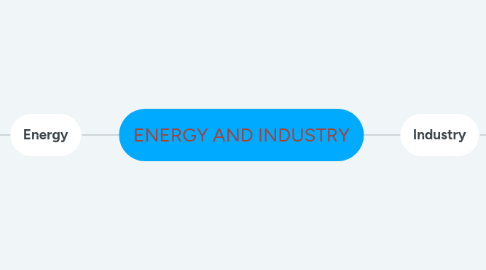
1. Energy
1.1. types
1.1.1. electricity, oil and gas- late 19th century
1.1.2. coal
1.1.2.1. 19th century
1.1.3. nuclear energy
1.1.3.1. 20th century
1.1.4. wind, solar and wave power
1.1.4.1. 1973
1.2. how they are
1.2.1. renewable
1.2.1.1. definition
1.2.1.1.1. those that can recover naturally
1.2.1.2. types
1.2.1.2.1. hydroelectric
1.2.1.2.2. wind
1.2.1.2.3. biomass
1.2.1.2.4. solar
1.2.1.2.5. geotermal
1.2.1.3. advantages and drawbacks
1.2.1.3.1. advantages
1.2.1.3.2. drawbacks
1.2.2. non-renewable
1.2.2.1. definition
1.2.2.1.1. exist in limited amounts and can not easily be replaced
1.2.2.2. types
1.2.2.2.1. oil and natural gas
1.2.2.2.2. coal
1.2.2.2.3. nuclear energy
1.3. where are they found
1.3.1. primary
1.3.1.1. obtained from nature
1.3.1.1.1. coal uranium and renewable energies
1.3.2. secondary
1.3.2.1. produced from a primary source
1.3.2.1.1. electricity and petrol
2. Industry
2.1. definition
2.1.1. trasformation of raw materials into manufactured goods
2.2. required conditions
2.2.1. machines and energy
2.2.2. work is carried out in factories
2.2.3. large quantities of goods are produced
2.3. types of industry
2.3.1. destination
2.3.1.1. basic
2.3.1.1.1. raw materials into semi-finished products
2.3.1.2. capital goods
2.3.1.2.1. uses semi finished products to make products for other companies
2.3.1.3. consumer goods
2.3.1.3.1. make consumer products
2.3.2. development
2.3.2.1. mature
2.3.2.1.1. textiles
2.3.2.1.2. iron and steel
2.3.2.2. advanced
2.3.2.2.1. biotechnology
2.3.2.2.2. microelectronics
2.4. characteristics of modern industry
2.4.1. the new industrial model
2.4.1.1. based on new technologies and industries
2.4.2. the key role of research
2.4.2.1. new materials
2.4.2.2. technology
2.4.3. the desentralization of production
2.4.3.1. globalisation
2.4.3.1.1. differents phases of production
2.4.3.1.2. subcontracts
2.4.3.1.3. coperation agreements
2.4.4. automation and industrial tertiarization
2.4.4.1. fewer workers are required
2.4.4.2. demand for technicians and professionals
2.4.5. the growth of multinational industries
2.5. the industrial powers
2.5.1. traditional
2.5.1.1. USA
2.5.1.1.1. second place
2.5.1.2. Japan
2.5.1.2.1. third place
2.5.1.3. Europe
2.5.1.3.1. Germany, Italy, France, UK
2.5.2. emerging
2.5.2.1. BRICS
2.5.2.1.1. Brazil
2.5.2.1.2. Russia
2.5.2.1.3. India
2.5.2.1.4. China
2.5.2.1.5. South Africa
